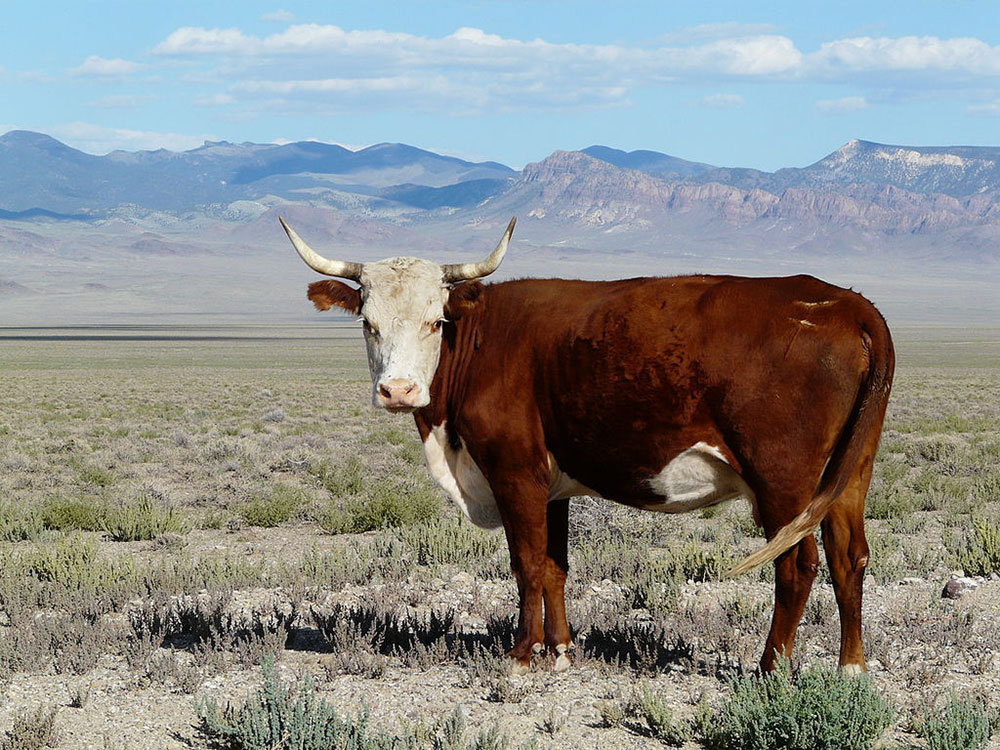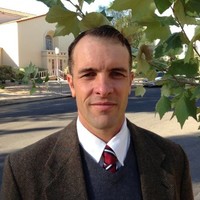“Local,” they say, “never goes out of season.” The people making this claim usually drive expensive hybrids and consume above average quantities of whole-grains, but they nevertheless have a point. The counterpoint, however, is subtly delivered in weekly specials of “89 cents a pound!” and is made by well-rounded grocers driving SUVs. They also have a point. Like all catchphrases they both ignore some important truths. At Double Check Ranch, we’re caught between the two as we fervently try to discover the proper balance among pragmatic economics, sustainable stewardship, and our own personal pursuit of happiness. And you thought we just raised cows.
Background
As a way to counter an often fickle, steadily worsening cattle market, our family began direct marketing grassfed beef 14 years ago. My mother and father patiently pioneered Tucson’s earliest farmers’ markets, diligently explaining the benefits of grassfed beef to people who assumed that all cows ate grass all the time. Now, a decade and a half later, my wife and I are trying to meet the increasing, dare I say insane, demand for local grassfed beef. In the process we’re hoping to demonstrate a sustainable new model for family-scale ranching. Our operation is unique in that we own the entire beef cycle. From “pasture to palate,” we control every aspect of the product our customers eat. We raise cattle on twelve thousand acres of Arizona/New Mexico range, finishing them on irrigated pasture along the San Pedro River north of Tucson. After finishing, we slaughter and process right on the ranch in our own state-inspected packinghouse, which enables us to control the critical final stages of beef production.
At Double Check Ranch, we’re caught between the two as we fervently try to discover the proper balance among pragmatic economics, sustainable stewardship, and our own personal pursuit of happiness.
This vertically integrated process more than doubles the per head return of a standard cow-calf ranching operation, allowing us to contemplate stewardship projects that might otherwise go undone and to focus on the things that make us happy. It’s too early to call our model lucrative, but it certainly appears to be financially and emotionally sustainable.
Economics
“Ah,” the flinty-eyed economist in you says, “but isn’t your scale of production terribly inefficient, supported only by the bubble-heads infatuated with local food?” And you’re right; I would be the first to admit that this particular method of converting solar energy into cash flow is subject to the whims of a health- and eco-conscious clientele. But frankly, I’ll take my chances with the whims of a clientele I can see and know over a clientele that insists on ninetynine cent Whoppers for two decades in a row. For years now, corporate cattle buyers have been offering lower prices even as they grow feedlot production and processing systems beyond any resemblance to the picture-perfect farms they display on their packaging. In 1970, a pound of beef cost nearly five adjusted dollars. Now it costs two. In 1970, a rancher could buy a new pickup (the standard western asset index) with 15 steers. Now it takes 44.
As to clientele, I have to say that the genuine appreciation we get for our product is a large part of our compensation package. Our customers are interested in what they eat, justifying their purchase on far more than price-point. They love the proximity of their food production, they love their connection to it, and they are willing to pay for our lack of economies of scale. I suppose it’s somewhat akin to the hunter who, if he actually breaks it down, finds he’s “paid” $35 a pound for elk meat. What you eat is about more than just shelf price.
And speaking of economics, one of the creative joys in this business is the entrepreneurial pursuit of turning liabilities into assets. To paraphrase British economist Lionel Robbins, economics is about finding alternative uses for scarce resources. We’ve turned a horrible, disgusting problem of offal disposal into rich, high-octane compost. We’ve turned beef fat from a health hazard into biodiesel that runs our trucks and tractors. We’ve turned old fence wire into absurdly high-priced Christmas wreaths. And on and on. I suppose “industrial” beef operations do an even better job of utilizing every ounce of a beef carcass by selling every scrap and drop to the highest bidder, but I doubt they have as much fun.
Sustainable Stewardship
Sustainable stewardship is one of those wince-inducing phrases that means all things to all people. For us, it means profitably harvesting a wholesome food source with practically no external inputs beyond sunlight, water, and our own energy; an activity that can reasonably be expected to continue unchanged for generations to come.
Our stewardship begins by countering the common misunderstandings that livestock are destructive toward landscapes and that their impacts should be limited or mitigated by agencies with the wisdom and resources to control them. Viewing livestock as an inherently destructive force to be minimized entirely ignores the well-established relationship between herbivory and grassland ecology. Grasslands, and to some extent riparian and forest systems, have co-evolved with grazing ungulates and generally respond positively to periodic tissue removal. To be sure, livestock impacts can be detrimental, but the overgrazing effects that can lead to landscape denuding, erosion, and biodiversity loss are not a factor of livestock activity or numbers per se. Rather, they result from the mismanagement of that livestock.
Our stewardship begins by countering the common misunderstandings that livestock are destructive toward landscapes.
A landscape’s ecological health is dependent on rest as well as grazing, and it is vitally important that livestock impacts be concentrated, pulsed, and removed after the impact. These concepts were articulated by Allan Savory more than twenty years ago in his book on Holistic Resource Management and have had remarkable success around the globe, turning barren landscapes into vibrant grasslands, improving watershed rainfall effectiveness, and restoring biodiversity. In short, managed grazing, which capitalizes on a natural structure of concentrated grazing followed by established rest periods, can turn livestock into an ecological asset rather than a necessary evil.
But are we “green?” Another wince. People who emotionally relate to our way of life commend us for our “greenness” all the time. Calling someone green used to lead to gunfights out here, but now it means we can charge more. I doubt if we’re as green as they think. People are terribly excited about the notion of “food-miles,” the premise that the fewer miles food travels to reach one’s mouth, the better. This may resonate in some quaint corner of our minds, but I doubt that the carbon footprint a pound of my beef creates in traveling to Tucson towed in a diesel pickup (biodiesel notwithstanding) is significantly lower than a pound of Uruguayan beef traveling by shipping container.
Still, far be it from me to dissuade people from their madness. . . If being green means that we produce our beef without relying on taxpayer funded, artificially cheap corn feeds; without externalizing our costs into local aquifers and impinging on our neighbor’s property with obnoxious noise, dust, and pollutants; then I guess we’re “green.” I care deeply about the landscape that supports me, in part because my good management benefits me, not Mother Earth. Maybe it’s not politically correct, but brazen self-interest (well understood) is the only way to make the world a better place.
Pursuing Happiness
Paraphrasing Madison, every question is one between freedom and security. In our general pursuit of happiness, we confront this dichotomy more intimately, perhaps, than most. Giving up a comfy, predictable, well-paid lifestyle for one that depends wholly on one’s own wherewithal is a truly frightening thing. But freedom is a strong incentive, and we now allocate our time and energy to whatever we deem best. We eat our meals as a family; we play and work outside; we read, ride horses, play the piano, watch chickens, and go for walks when we want to. Of course, we aren’t on vacation all the time, far from it. We work longer days doing harder labor than ever before. Being free from the direct caprices of bosses and bureaucracies does not mean you are free from want or from the necessity to feed and clothe one’s family. Inevitably we find ourselves stressed and unhappy at times. But there seems to be a big difference when pressure comes from within.
I care deeply about the landscape that supports me, in part because my good management benefits me, not Mother Earth.
All in all, I suspect that we’ve found our own particular version of Aristotle’s “middling way,” while attempting to negotiate the balance between excess and deficiency. I wouldn’t congratulate ourselves for doing this intentionally; we bounce through the ruts like anyone else. But I must confess a certain contentment of spirit, an appreciation for what we craft that I suspect is lacking in many lives.
Anyway, this has become a far preachier article than I had intended. I like what I do, I find myself doing it even on “days off,” which is probably a good sign.
At the end of the day, the model of sustainable ranching that we promote is by no means perfect. It’s costly to consumers, it’s physically and financially demanding for producers. But if nothing else, it is honest; the costs are a direct reflection of the necessary inputs. We live in intimate proximity to the processes that give (and take) life. We, in turn, give back to the land, leaving it richer and more fecund than we found it. As long as we have consumers who value that, our business will thrive.
Paul Schwennesen manages Double Check Ranch with his wife Sarah. After graduating from the U.S. Air Force Academy and separating as a captain, he received a master’s degree in government from Harvard University, something that impresses the livestock not at all. He is a PERC Enviropreneur Institute graduate and can be reached at schwennesen@mac.com.




